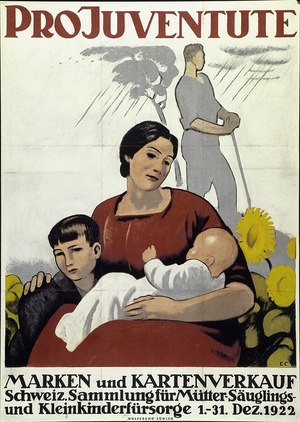
Unternavigation
Swiss Philanthropic Society (SGG)
The notion of social responsibility formed the foundation of the Swiss Philanthropic Society and other associations dedicated to public welfare and social reforms. The social question as well as education and family policy were at the heart of the work carried out by SGG, which provided a platform for bourgeois debates on social reform in the 19th and 20th century.
Since its inception in 1810, the Swiss Philanthropic Society (SGG) encompassed a number of different charitable organisations primarily involved in the social and educational sector. Liberal figures from the Catholic and Protestant denomination were equally active in the society. The SGG was considered an important forum for discussion amongst the reformist elite. Women were also represented in the society; they founded the Swiss Philanthropic Women’s Association in 1888.
Over the course of the 19th century, the SGG established numerous homes and schools for the needy and trained teachers. In the 20th century, it was able to provide financial support to various social schemes and initiatives thanks to its assets from donations and bequests. It was closely involved in the establishment of foundations like Pro Juventute (1912), Pro Senectute (1917) and Pro Mente Sana (1978).
The SGG was committed to bourgeois, liberal values and private initiatives in the sphere of social security. Initially, it was critical of the welfare state. Many members of the SGG preferred the expansion of private forms of social security and advocated a liberal system of provision. In their view, social insurance schemes represented an unwelcome competition with private welfare initiative that they preferred. Collective forms of provision would lead to the degradation of personal responsibility. However, at the end of the 19th century, differences of opinion also emerged within the SGG between an anti-statist wing that remained loyal to liberal ideals and exponents of social reforms. The latter was predominantly composed of protestant pastors, doctors, lawyers and politicians. Over the course of the 20th century, the SGG adopted a position in favor of an important development of the welfare state. This one was then considered not as competing against, but rather supplementing private initiative.
The SGG backed a health and accident insurance based on independent health funds. Yet, the bill drafted in 1900 as well as the act adopted in 1911 was criticized within the SGG; the charitable organization still feared an overly powerful state.
The economic depression of the 1920s and the global economic crisis of the 1930s (1932-1937) took private charity and public welfare to their limits. This bolstered the position of those within the SGG who favored state social policy. The SGG now supported an old age and survivors’ insurance (AHV) that would not compete with existing private pension funds. Not least, the SGG expected that expenditures for state and private welfare would fall as a consequence of introducing the AHV. The foundation dedicated to the aged (Pro Senectute) was founded in 1917 in order to campaign for the introduction of the AHV. In 1920, the SGG also established a commission for social insurance issues that backed the adoption of a constitutional article for the AHV in 1925.
The SGG became increasingly concerned with family policy during the 1930s. In 1932, it began managing the coordination of the Swiss Family Protection Commission to lobby for a number of policies including the general introduction of family allowances. During the Second World War, the commission was successful putting soldiers' family commitments on the agenda during the introduction the EO income compensation scheme (1939/1940). The SGG therefore supported the expansion of a welfare state based on protecting male breadwinners' income.
Despite this focus on family policy, the SGG continued to advocate the introduction of the AHV. Various experts involved in drafting the act of 1947 were members of the SGG. Besides being actively involved in the legislation, the SGG also helped to publicize the issues by organizing conferences and releasing publications. In its function as a social network for bourgeois groups interested in developing the welfare state, the SGG represented an important voice in the debate on social security – at least until the mid-20th century.
After the Second World War, during which social insurance programs were expanded, the SGG lost some of its momentum; although the organization still pursued the development of social legislation, it was no longer active in the process. It turned its attention to the care of the mentally ill. This shift in focus was crucial in the foundation of Pro Mente Sana in 1978. The SGG was also committed to redefining the role of private charity within the expanding welfare state. In the 1990s, against the backdrop of the economic crisis, the rise of ‘new poverty’ and the critical questioning of the welfare state, the SGG returned to activism that led to the modernization and reappraisal of voluntary work.
Literatur / Bibliographie / Bibliografia / References: Schumacher Beatrice (Hg.) (2010), Freiwillig verpflichtet. Gemeinnütziges Denken und Handeln in der Schweiz seit 1800, Zürich.
(12/2014)




